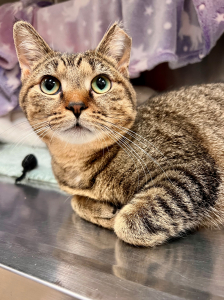
Harley The Auto Spas & Expresses Pet of the Week
House of the Week – 7/4/25

House of the Week!
7305 Parkview Dr | Frederick, MD | $497,000
Looking for move-in ready with modern updates in an established neighborhood? This upgraded rancher checks all the boxes! 
 Buyer Faves:
Buyer Faves:
 3 bedrooms |
3 bedrooms |  2 full baths
2 full baths Fully remodeled bathrooms (2022)
Fully remodeled bathrooms (2022) Stylish kitchen w/ new granite countertops (2023) + modern lighting
Stylish kitchen w/ new granite countertops (2023) + modern lighting Sunroom w/ new carpet (2025) & mini split—perfect year-round hangout
Sunroom w/ new carpet (2025) & mini split—perfect year-round hangout Large primary suite w/ walk-in closet, dual sinks & walk-in shower
Large primary suite w/ walk-in closet, dual sinks & walk-in shower Partially finished basement w/ LVP flooring
Partially finished basement w/ LVP flooring Oversized 2-car garage = workshop or extra storage
Oversized 2-car garage = workshop or extra storage Energy-efficient windows (2022)
Energy-efficient windows (2022) Upgraded electrical panel w/ generator hookup (2021)
Upgraded electrical panel w/ generator hookup (2021) New well + baffle (2025) = peace of mind
New well + baffle (2025) = peace of mind
 Located in the heart of Frederick—close to parks, shopping & commuter routes!
Located in the heart of Frederick—close to parks, shopping & commuter routes!
 Don’t miss your chance—click for details or schedule your tour today!
Don’t miss your chance—click for details or schedule your tour today!
House of the Week – 6/27/25

House of the Week!
210 Silver Stone Dr | Walkersville, MD | $465,000
Comfort, charm & convenience all wrapped into one!  Located in the Winter Brook community, this 4-bed, 2.5-bath split-level has everything you need.
Located in the Winter Brook community, this 4-bed, 2.5-bath split-level has everything you need.
 4 spacious bedrooms |
4 spacious bedrooms |  2.5 baths
2.5 baths Kitchen w/ island, pantry & gas range
Kitchen w/ island, pantry & gas range Crown molding + recessed lighting
Crown molding + recessed lighting Bright living & dining areas
Bright living & dining areas Partially finished basement w/ garage access
Partially finished basement w/ garage access Stamped concrete patio + landscaped yard = perfect for relaxing or entertaining!
Stamped concrete patio + landscaped yard = perfect for relaxing or entertaining!
 Great location in Walkersville—don’t miss this one!
Great location in Walkersville—don’t miss this one! Click for details or to schedule your private tour!
Click for details or to schedule your private tour!
Bradley Lowe
Mikey The Auto Spas & Expresses Pet Of The Week
MUNDANE MYSTERIES: Does Peeing On A Jellyfish Sting Actually Work?

Getting stung by a jellyfish can ruin a nice day at the beach. But does the old wives’ tale about peeing on a jellyfish sting actually help? Or work at all?
The sting of a jellyfish comes from specialized cells in the surface of its tentacles, known as cnidocytes. Each small, bulb-shaped cell holds a nematocyst, a barbed, threadlike tube filled with venom. On the outside of each cell is a tiny hair, called a cnicocil. And when that “hair trigger” is disturbed, the cell’s toxic harpoon explodes from its capsule into the skin of the jellyfish’s prey (an unlucky swimmer). The amount & type of venom, as well as the effect that it causes, depends on the type of jellyfish, the number of nematocysts involved, and the area & thickness of the skin they strike. Whatever the variables, a jellyfish sting is never fun.
The first step in treating a jellyfish sting is to remove any tentacles parts left behind on the skin without triggering any unfired nematocysts & making things worse. But pressure triggers the cells, so you can’t just pick them off, as whoever’s doing the picking will just get their fingers stung, too. Chemical changes, like throwing off the salt balance between the outside & inside of the cell, could also cause the stingers to fire…and that’s why urine isn’t really any good. Sure, urine contains salts, but it’s just too variable. Concentrated urine might do the trick, but if the person doing the peeing is well-hydrated, the urine will be too diluted with water, which will make the stingers fire. What’s more, while urine itself is sterile, its exit pathway isn’t, and that could lead to a bacterial infection for the sting wound.
Vinegar is usually your best bet; just the plain white stuff with 5% acetic acid, to neutralize any unfired nematocysts so they can’t sting anymore (best when combined lidocaine). But since most folks don’t usually bring vinegar & lidocaine to the beach, saltwater can also be used to rinse away remaining nematocysts. Once the stinging cells are deactivated, the stuck bits of tentacle can be picked off or scraped away with a credit card. A word of caution, though: vinegar might not be the best home treatment for all jellyfish stings, since acetic acid can actually have the opposite effect on stings from jellyfish lookalikes, like the Portuguese man o’ war. If you’re not sure what stung you, your best bet is to just stick with saltwater & seek help from a lifeguard or medical professional as soon as you can.
Got a Mundane Mystery you’d like solved? Send me an email at [email protected].


